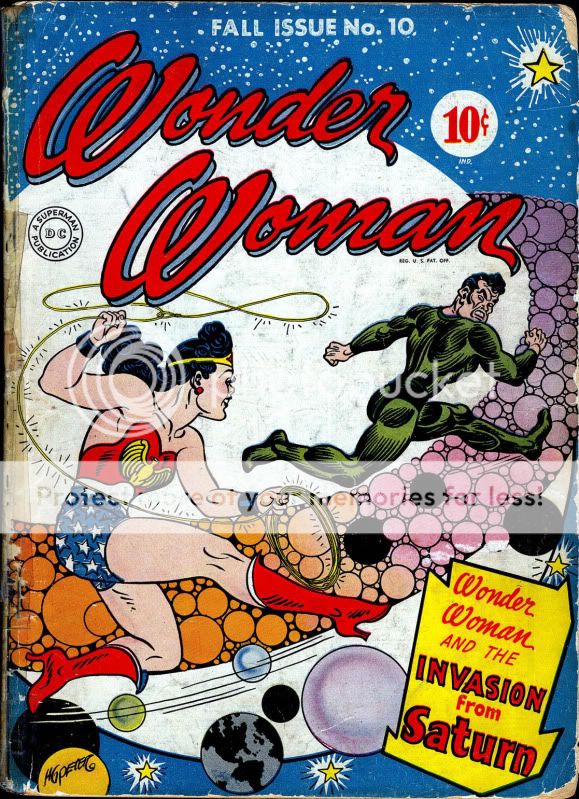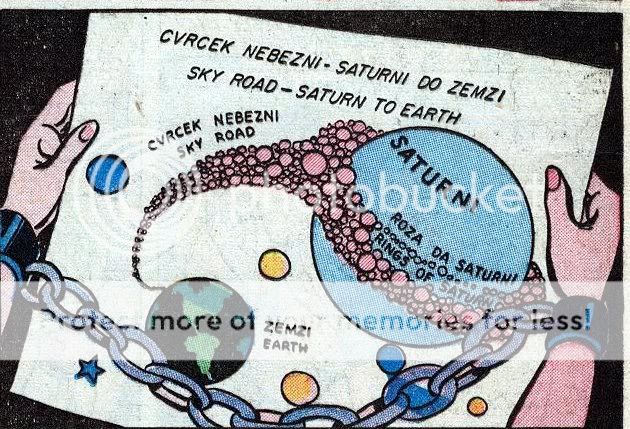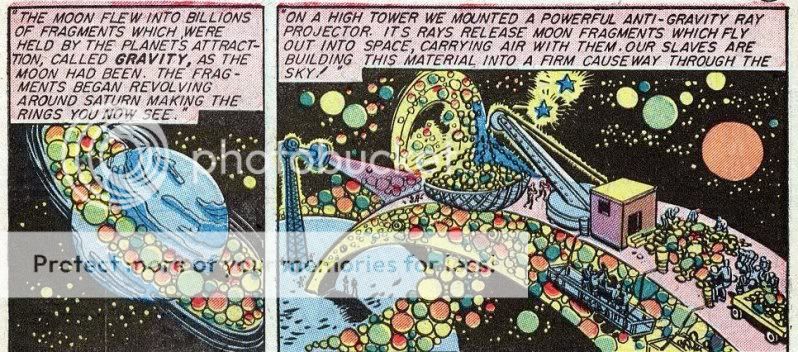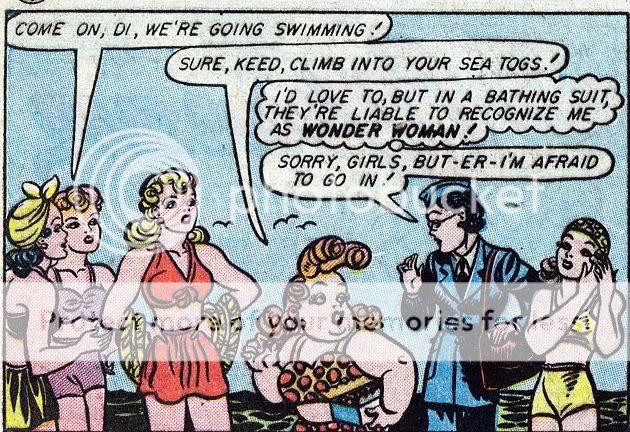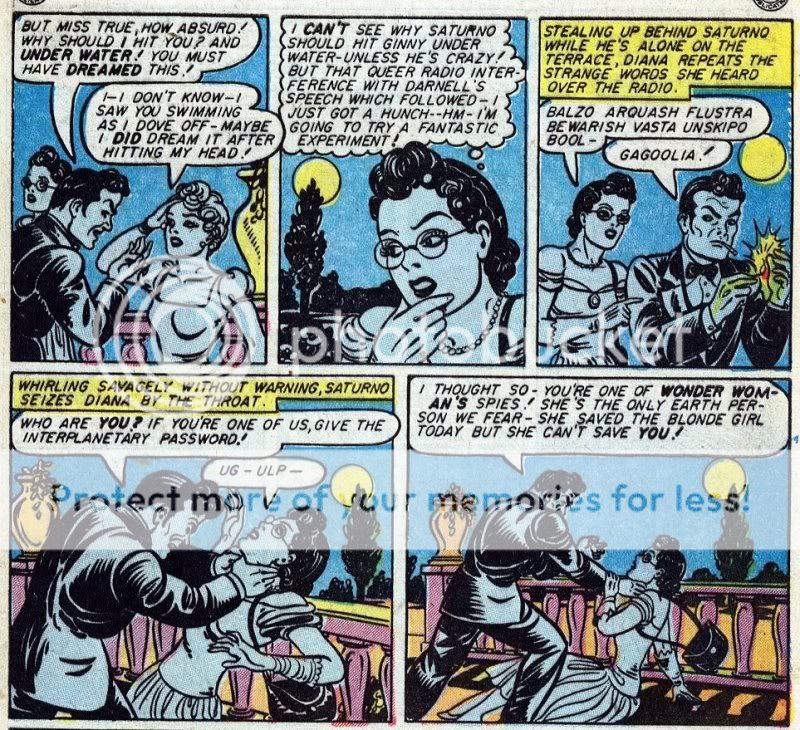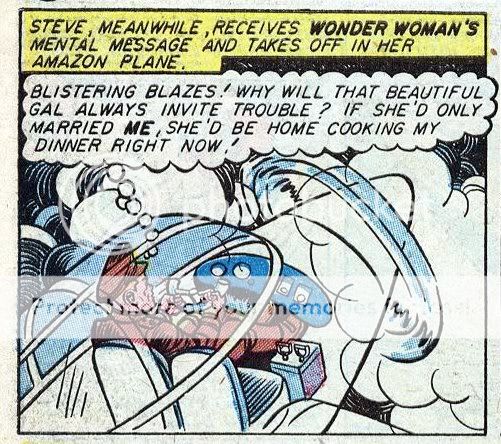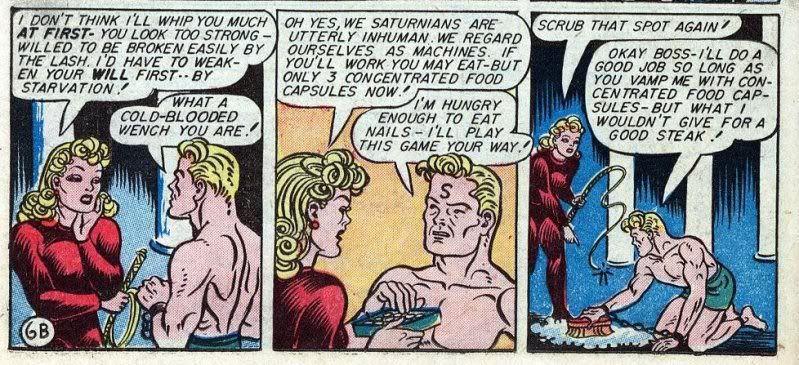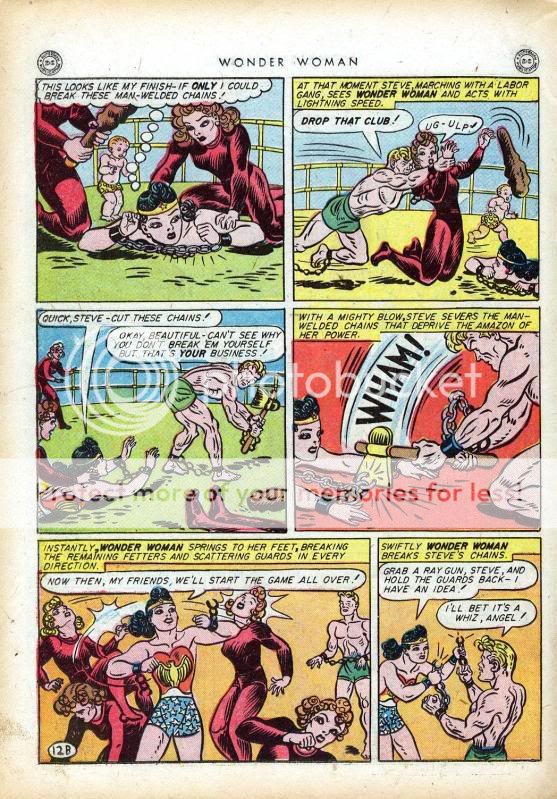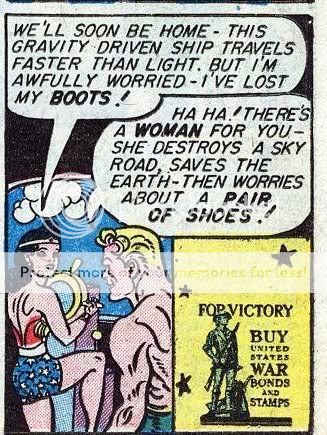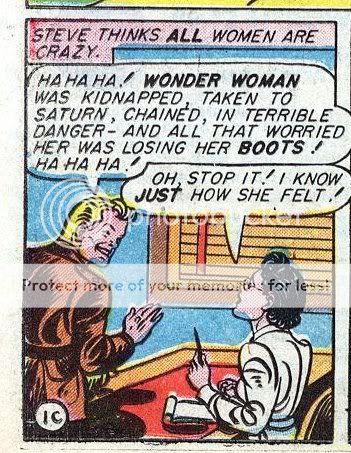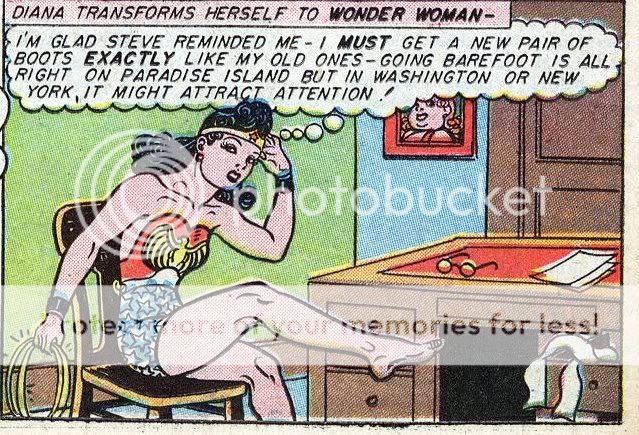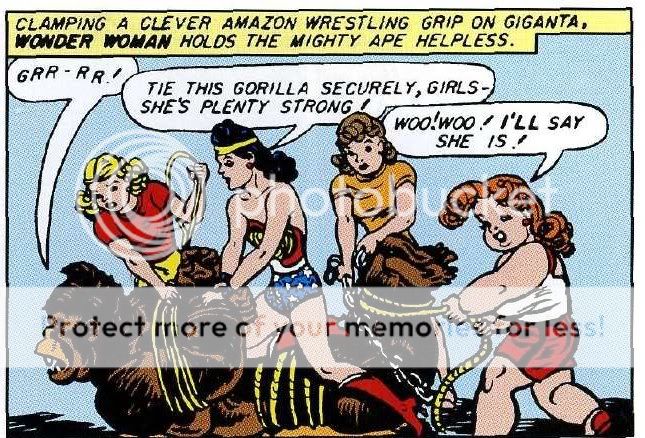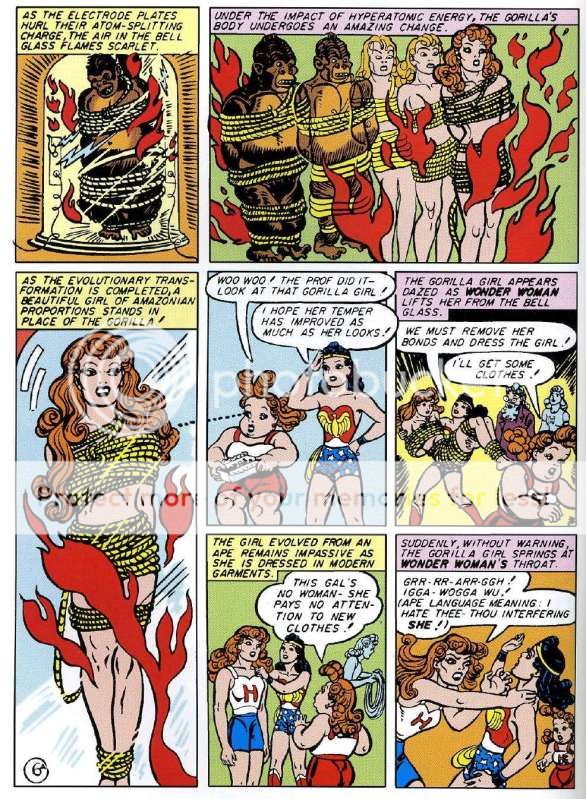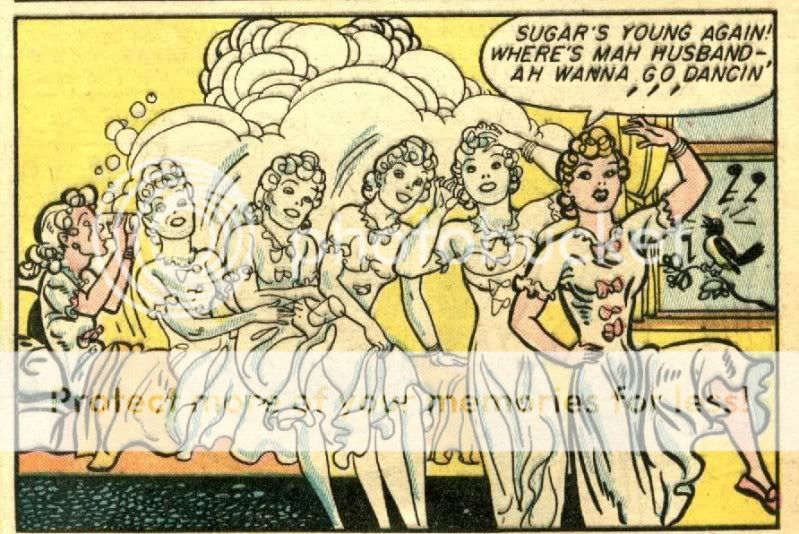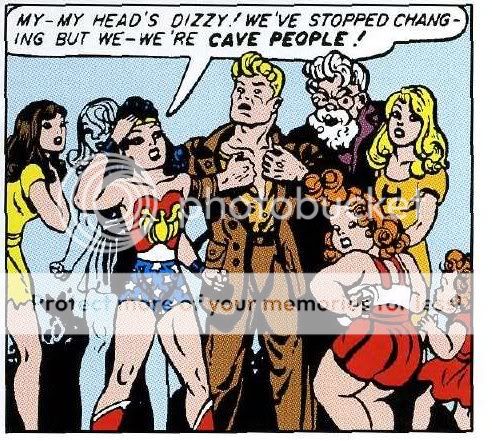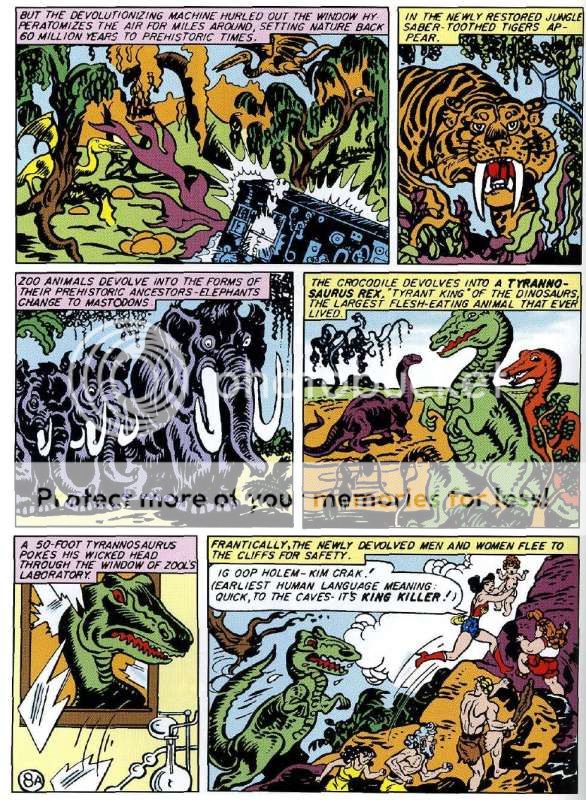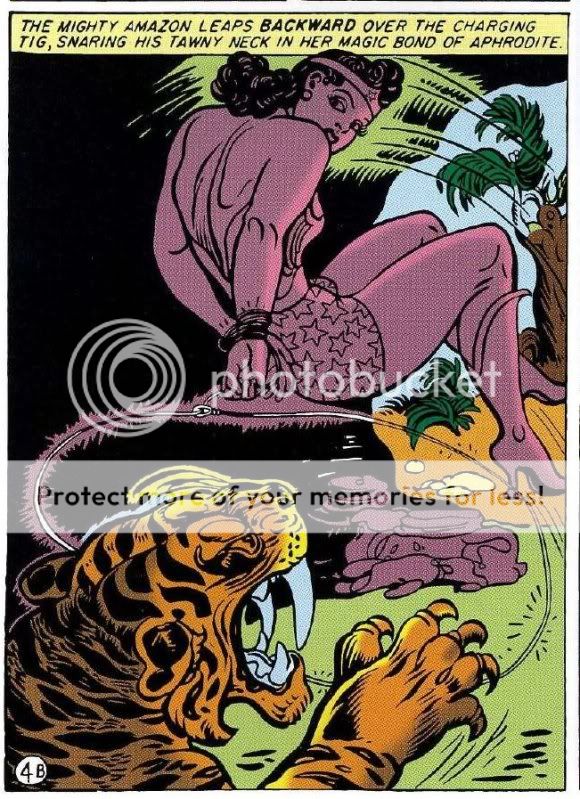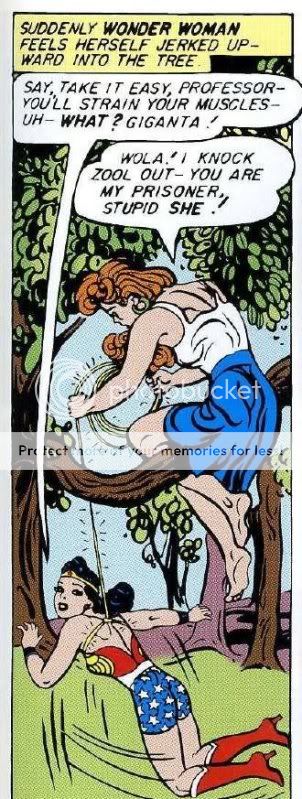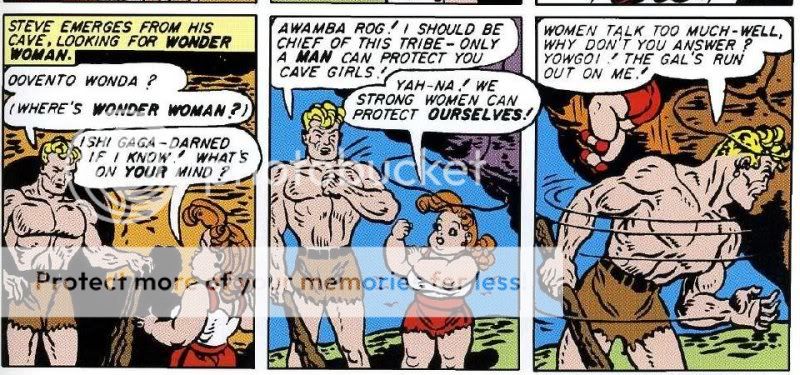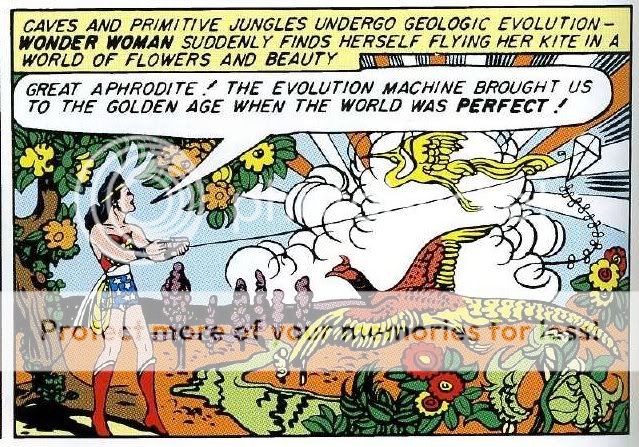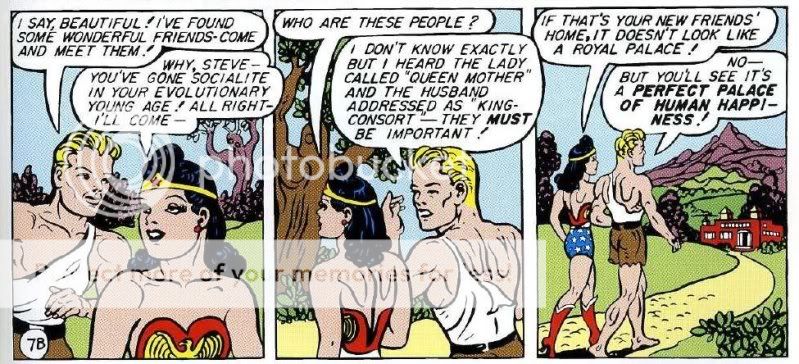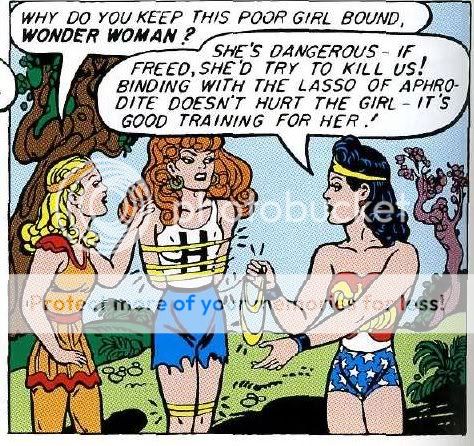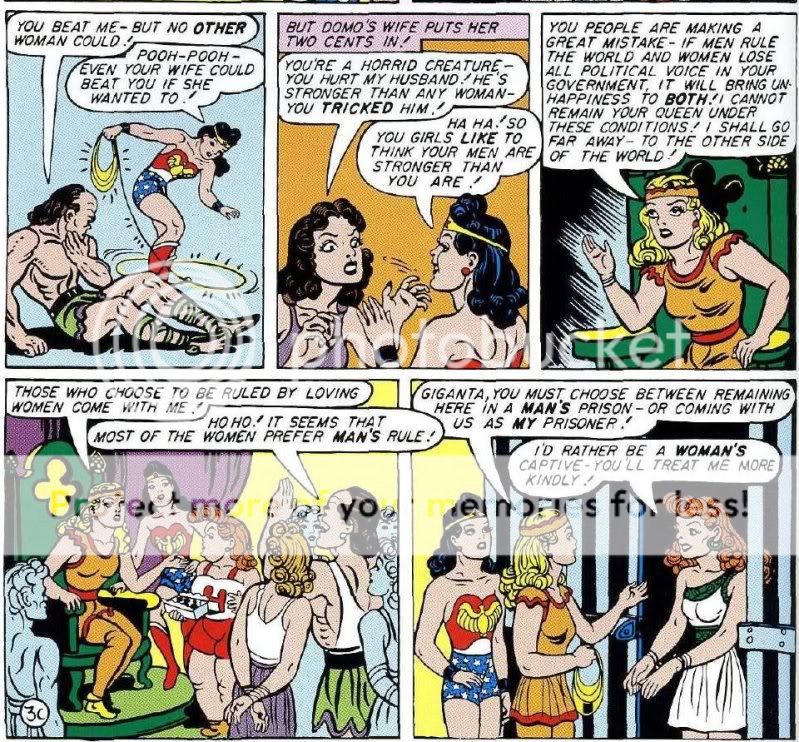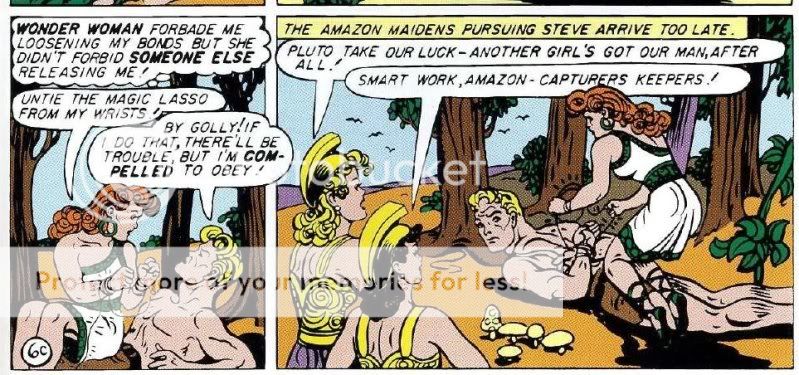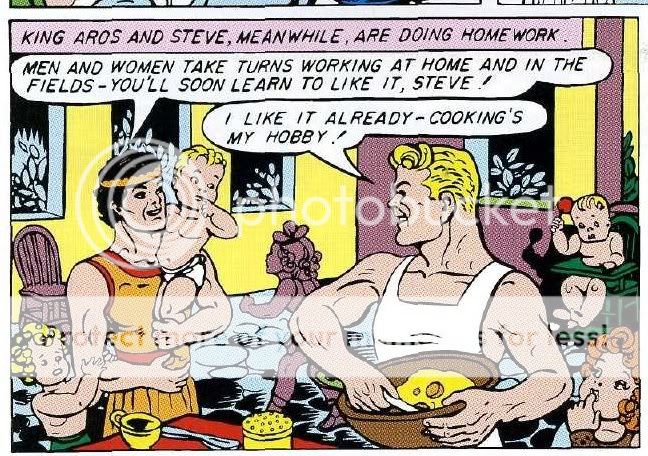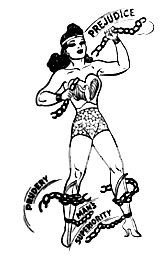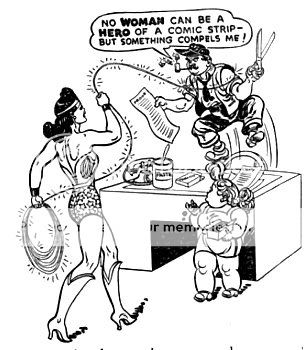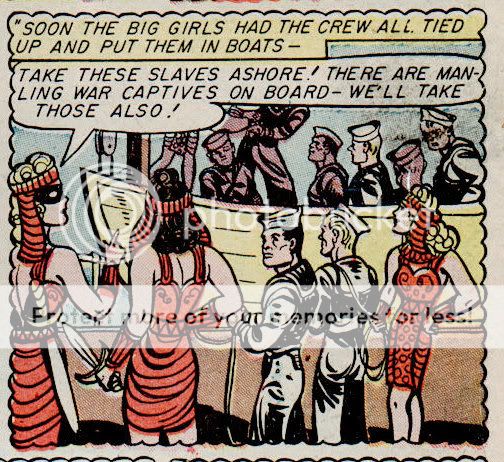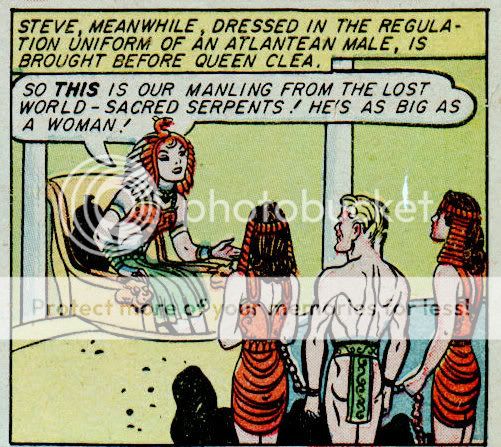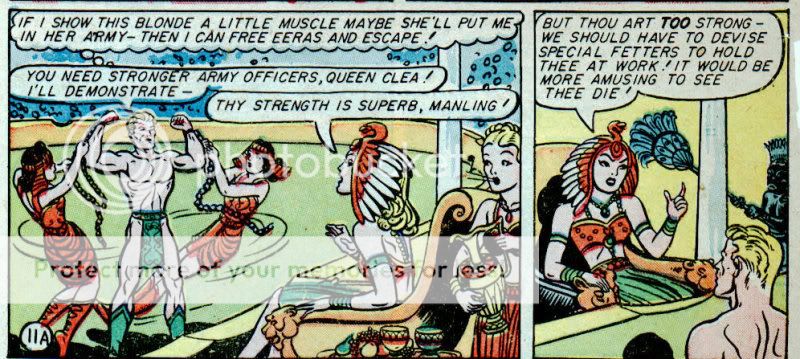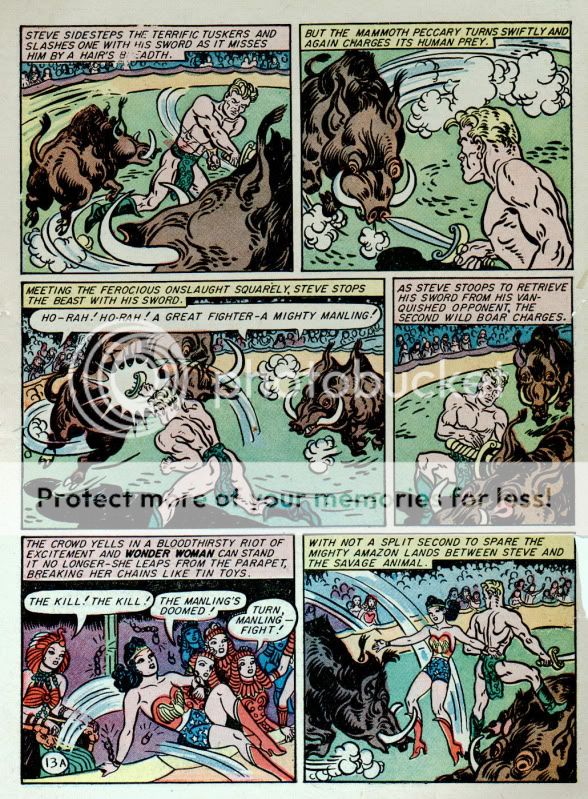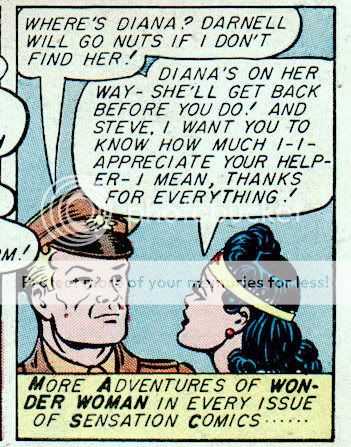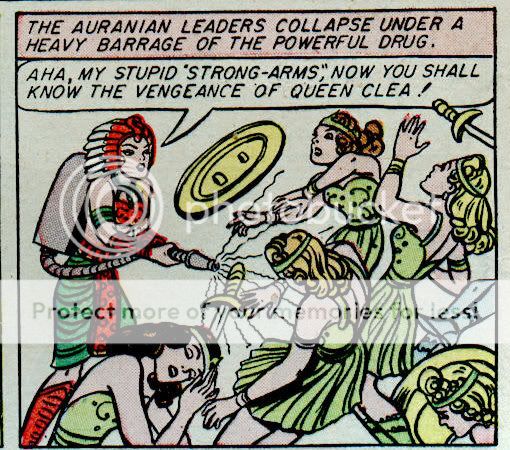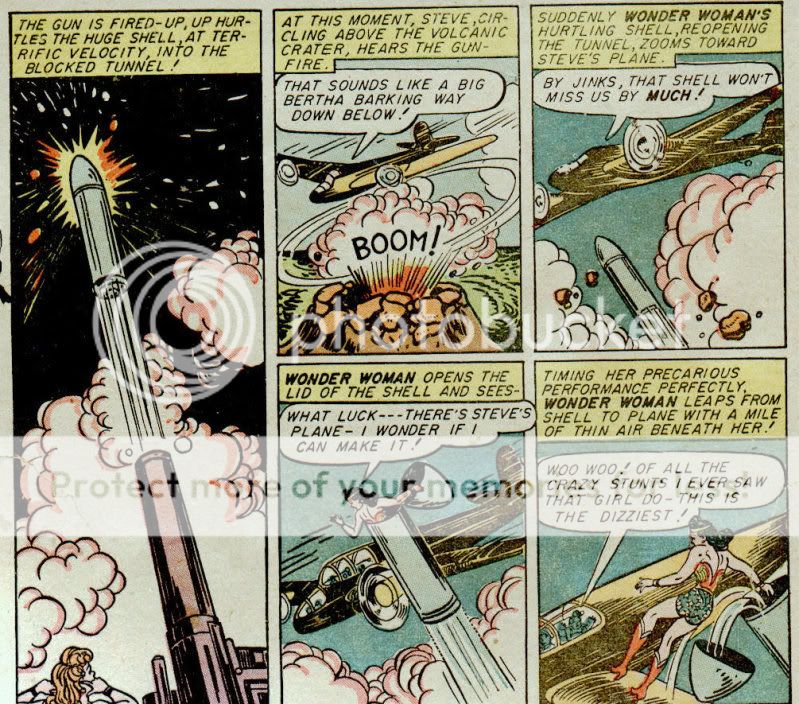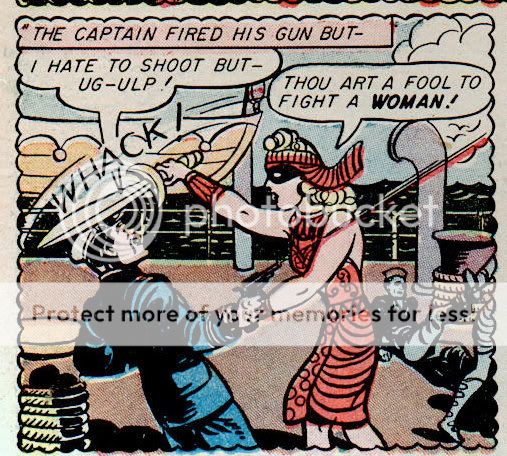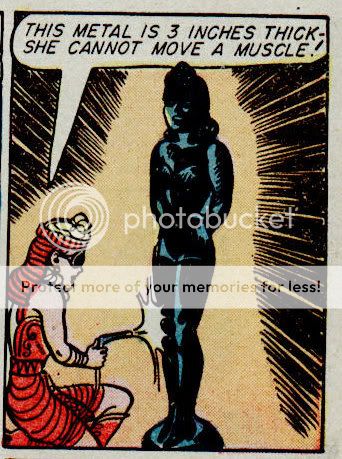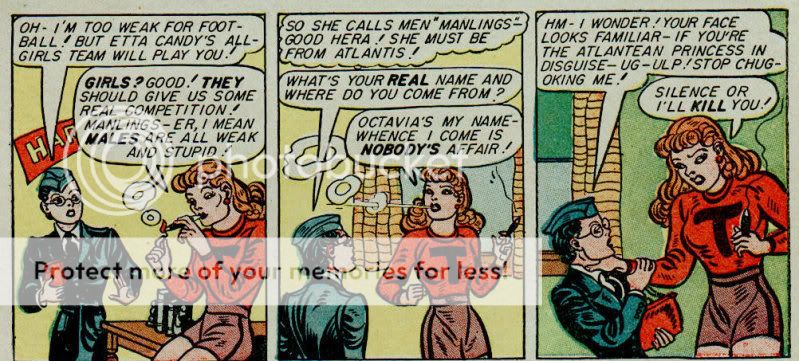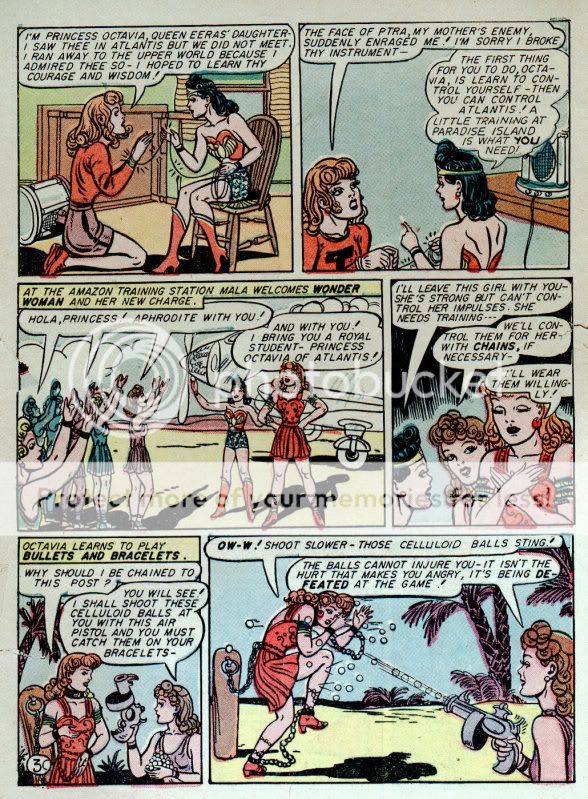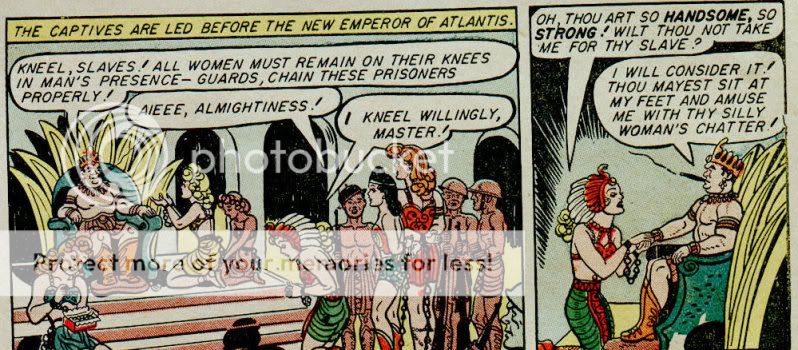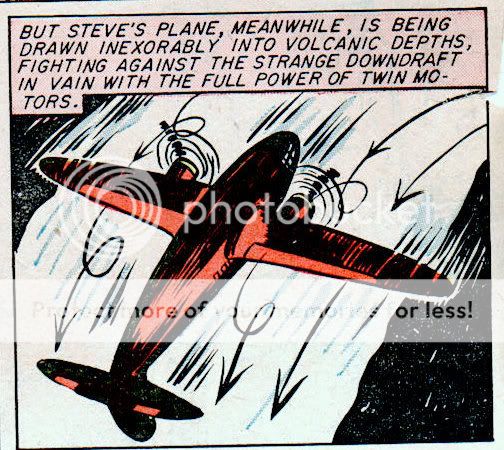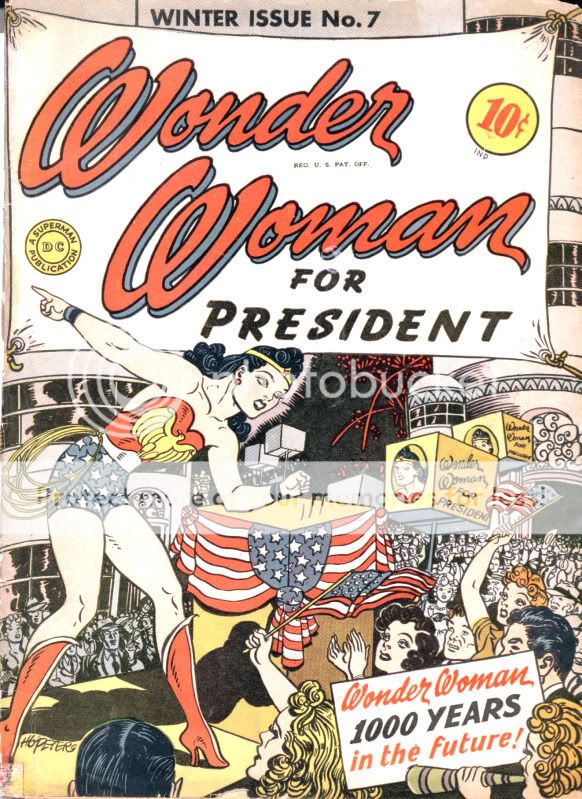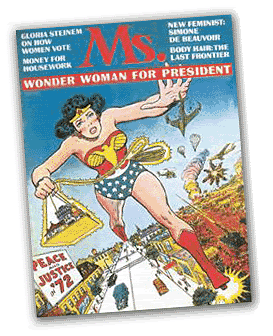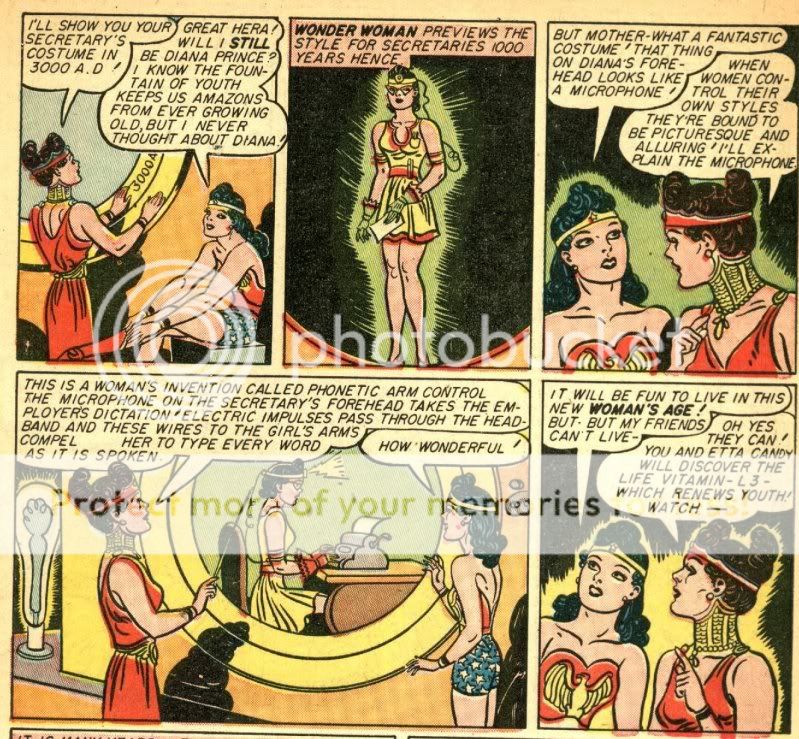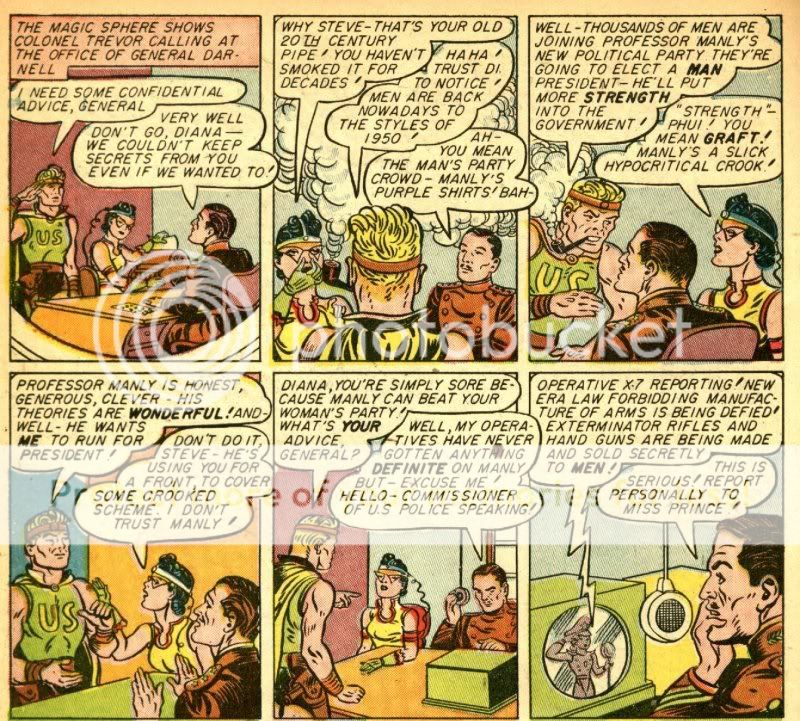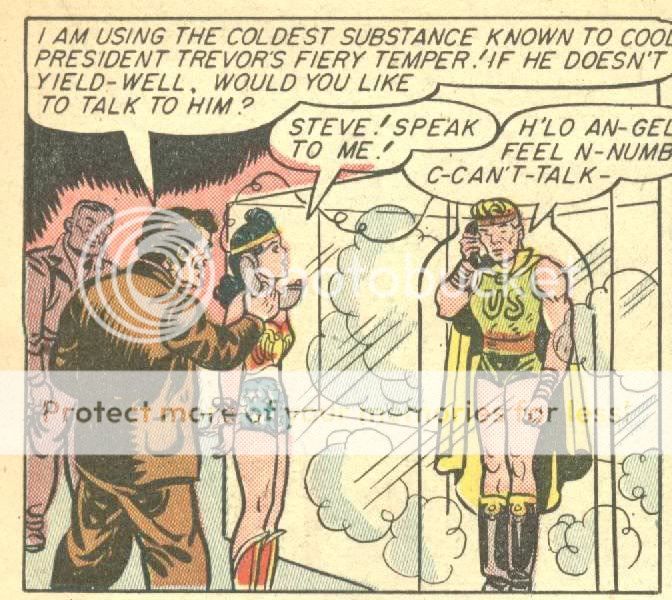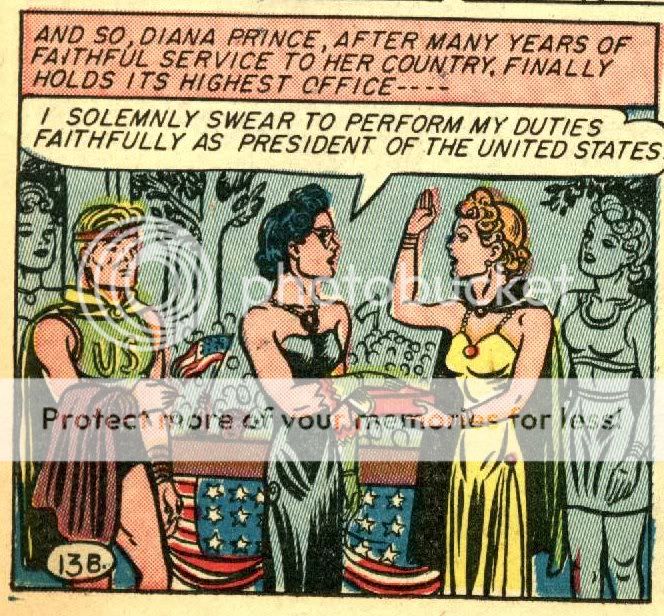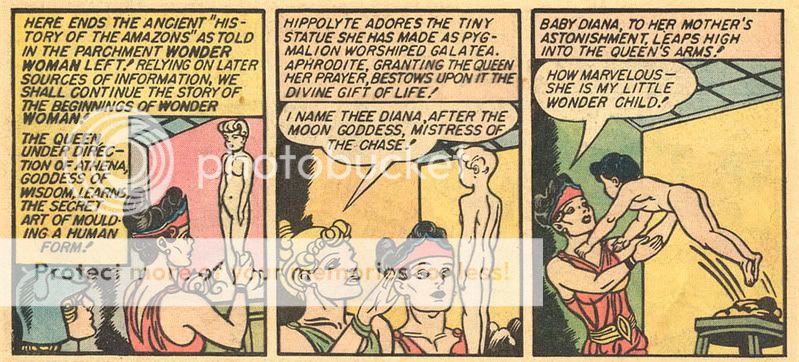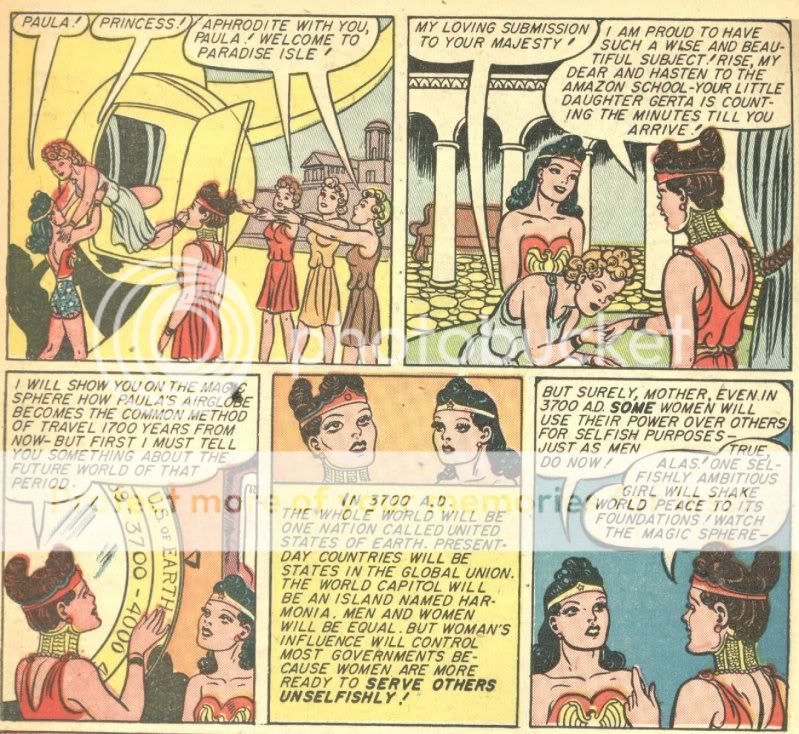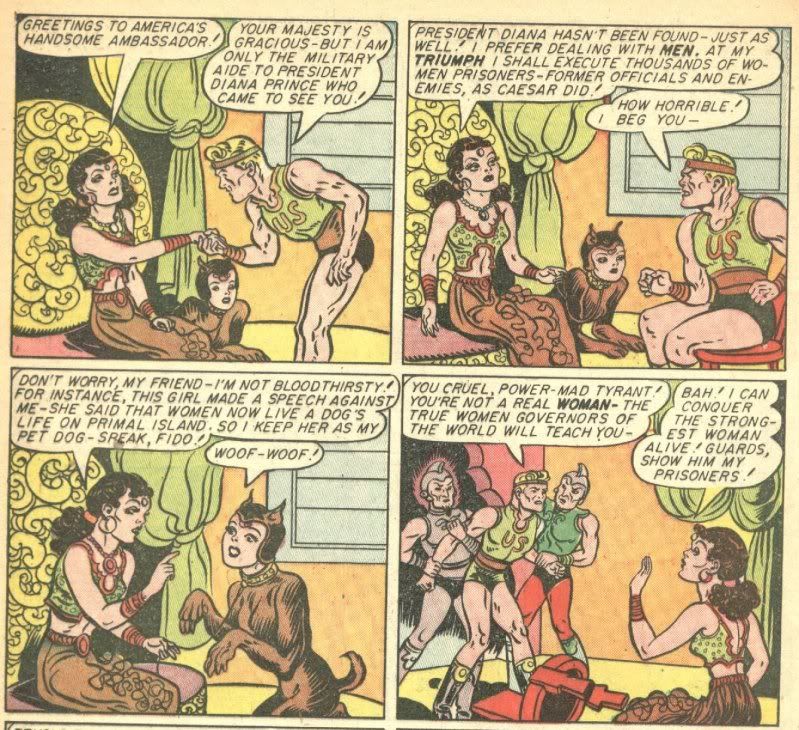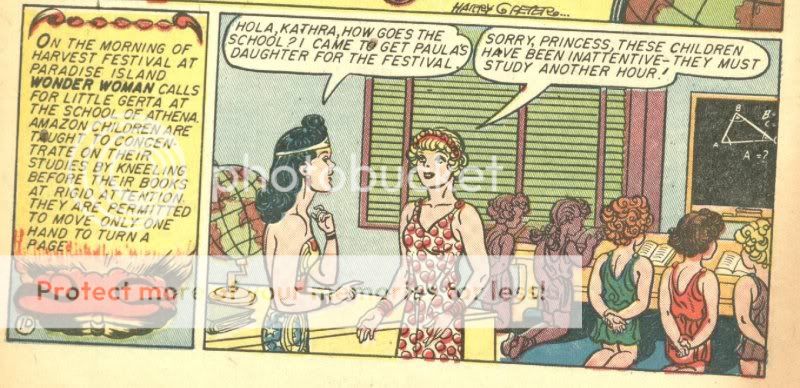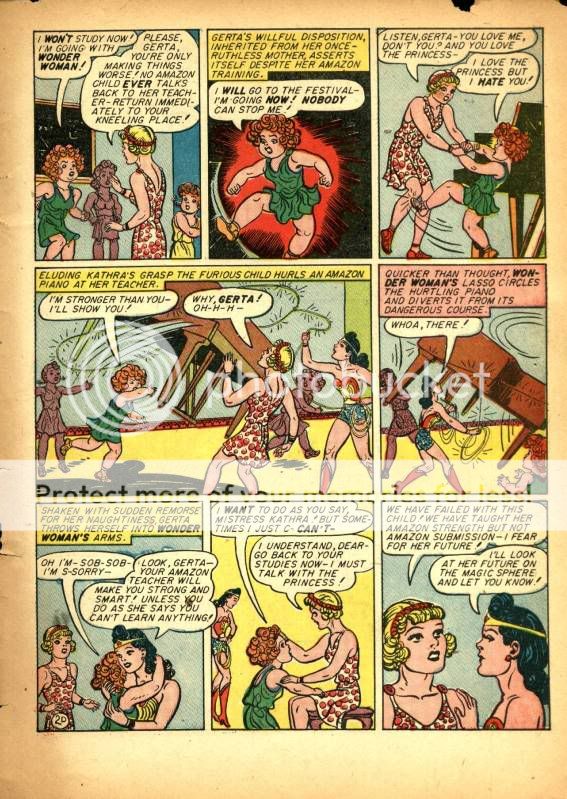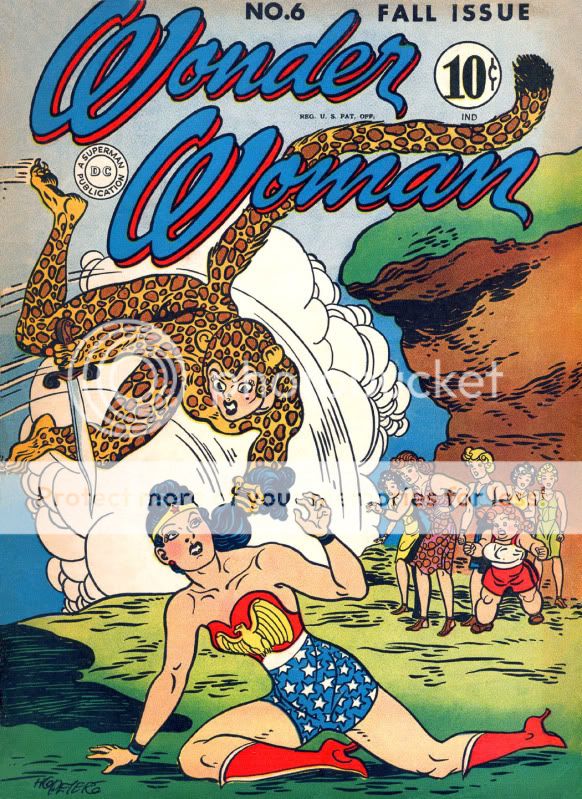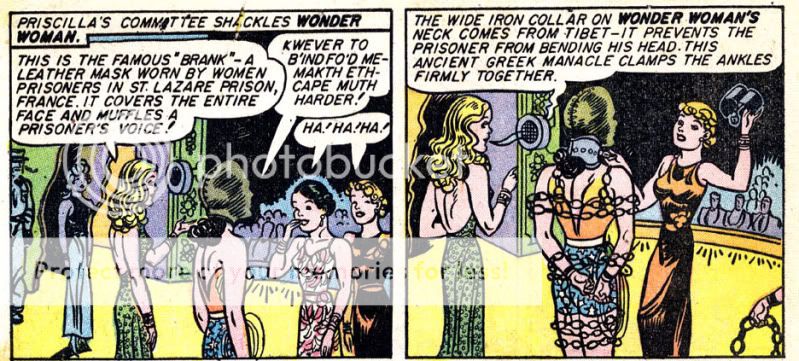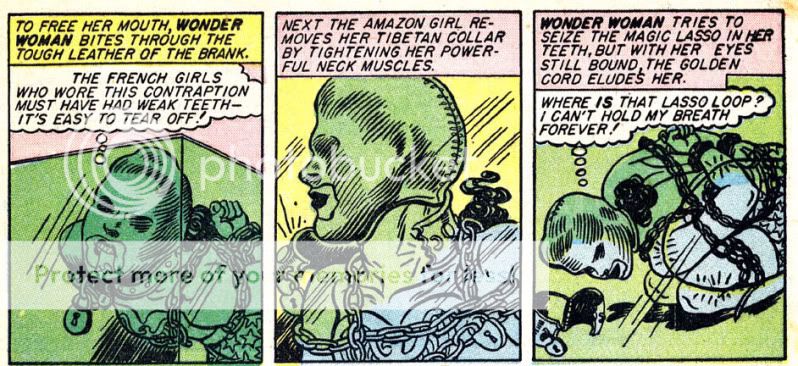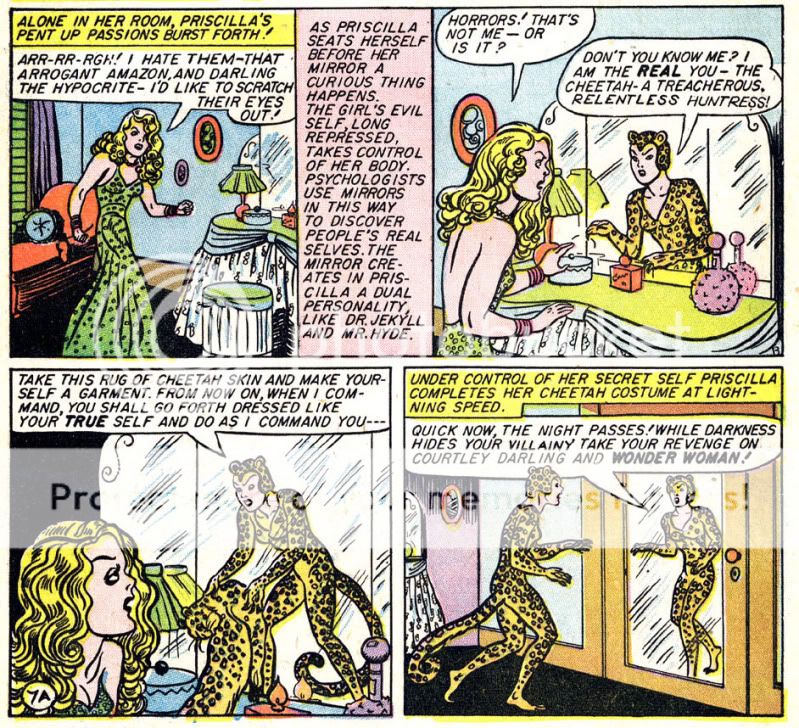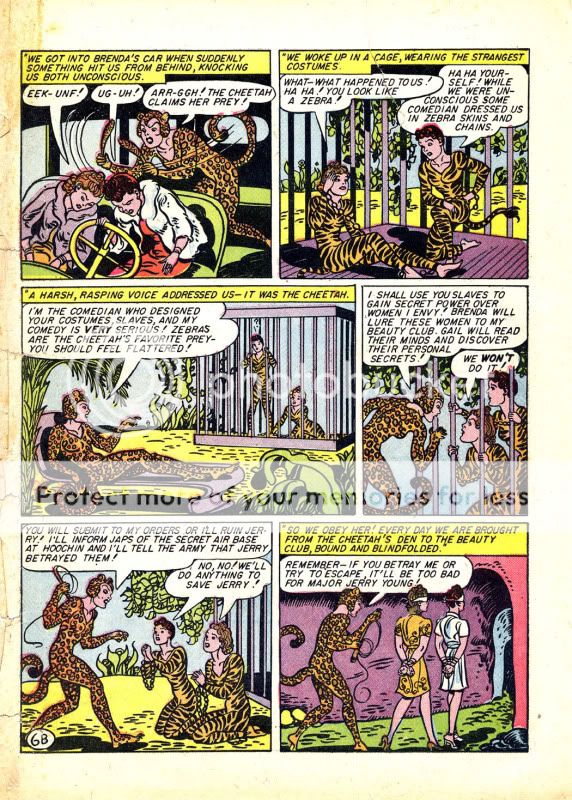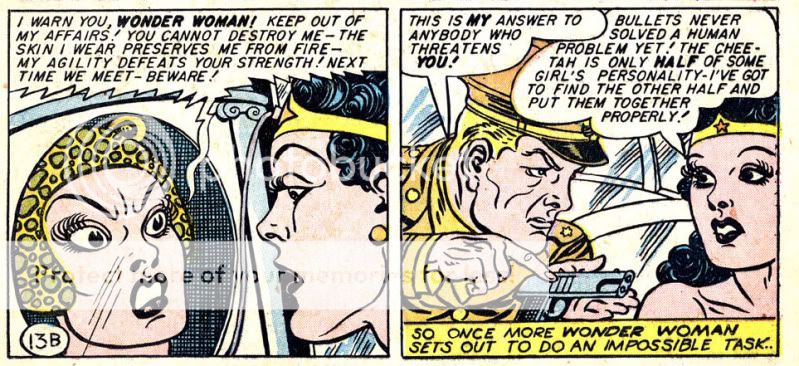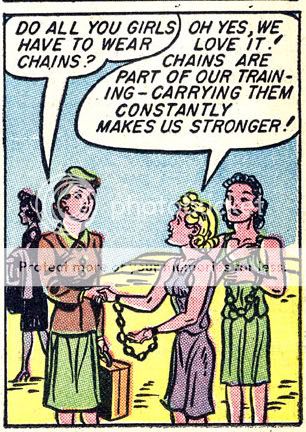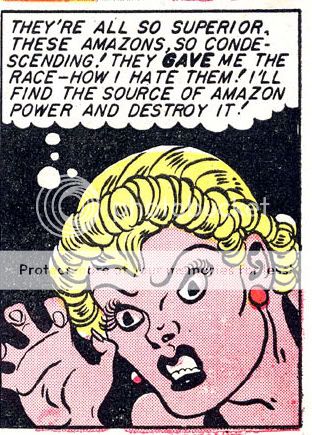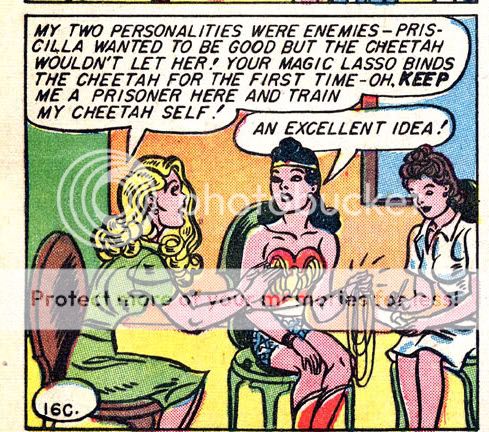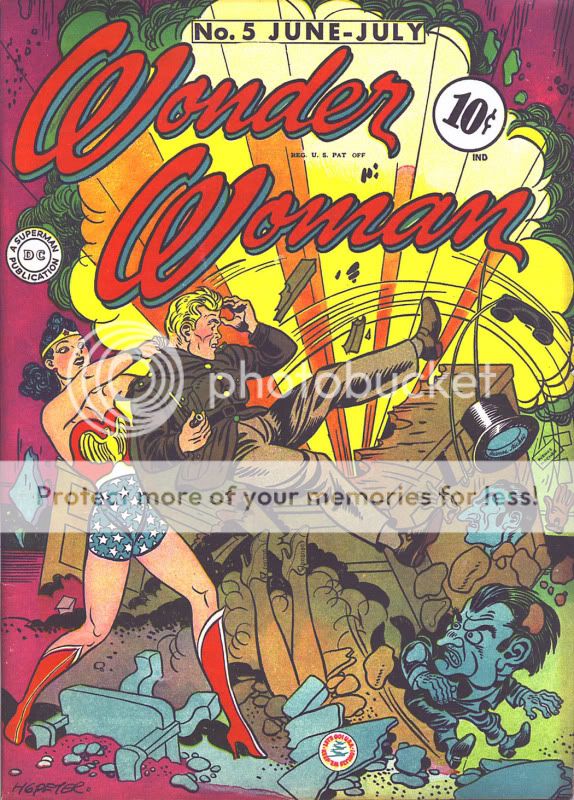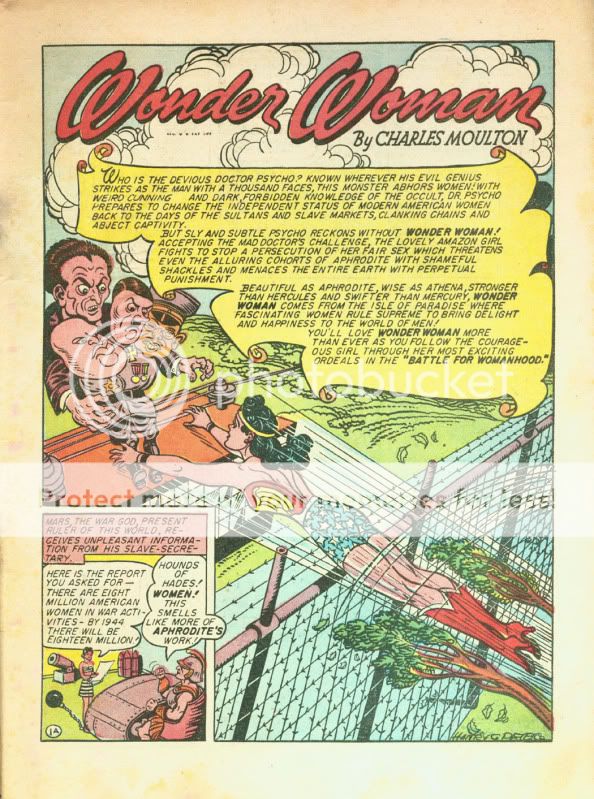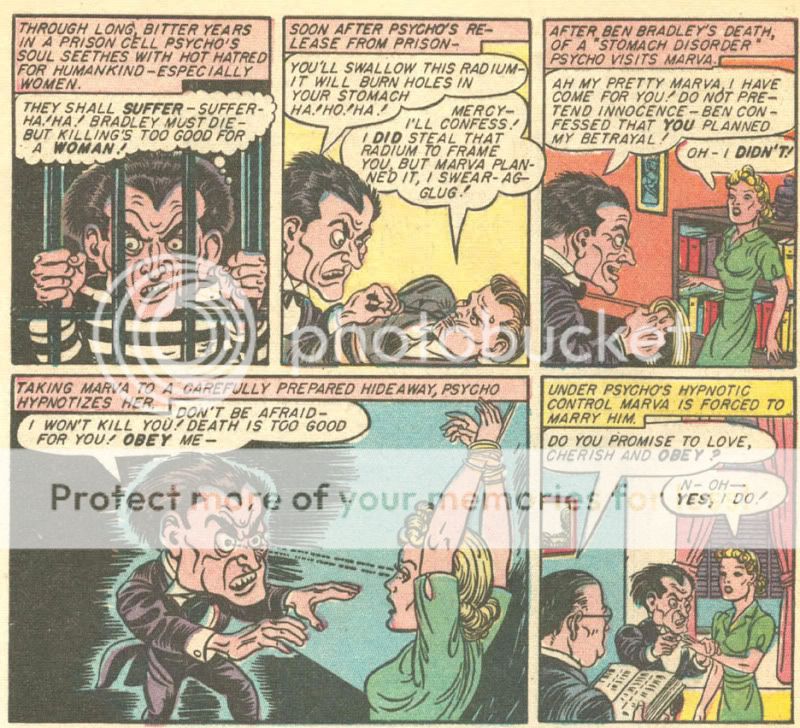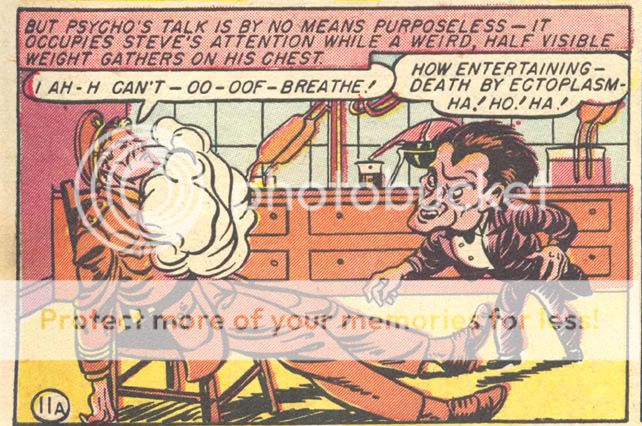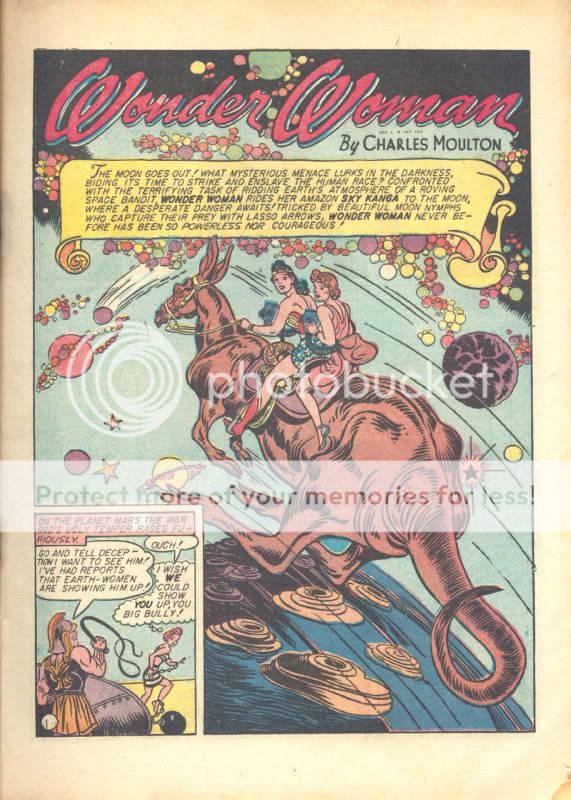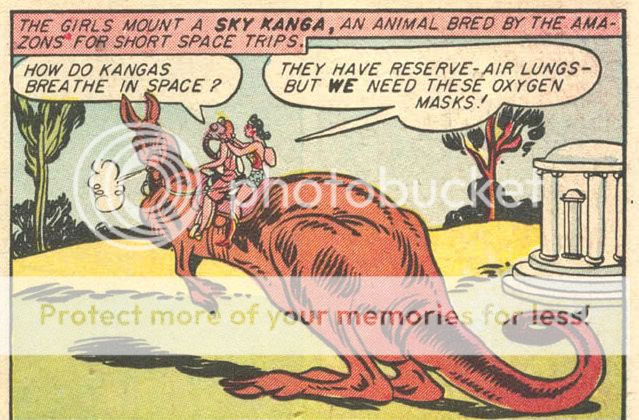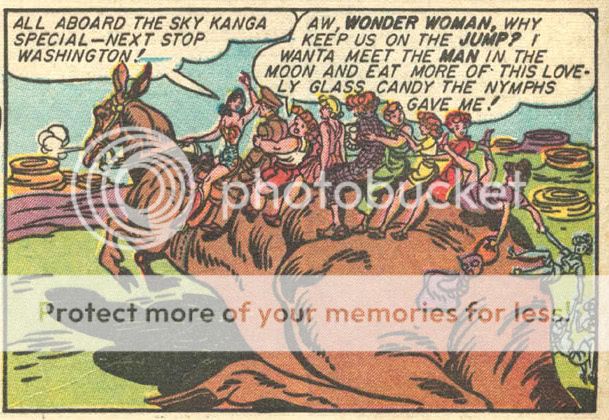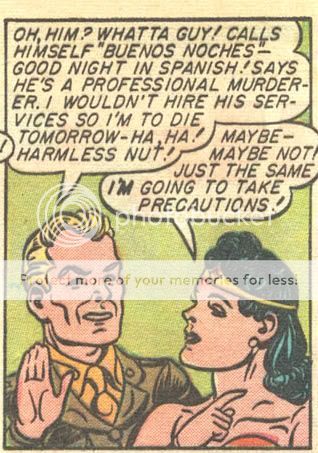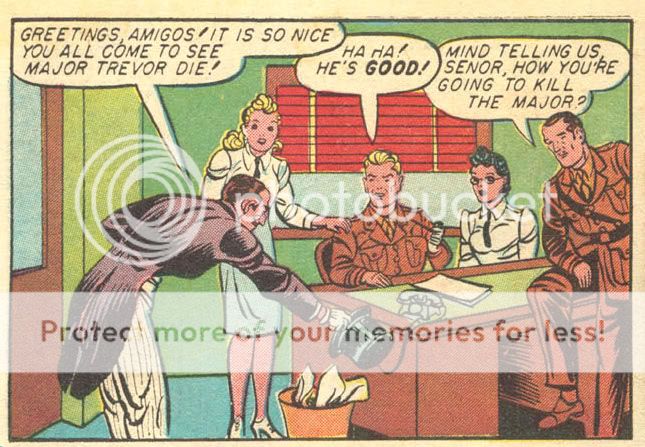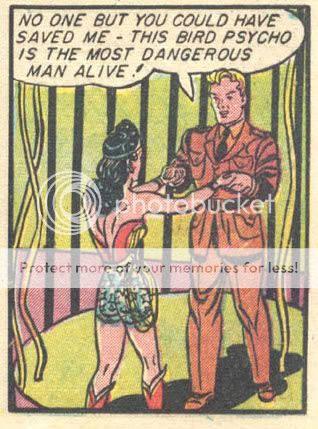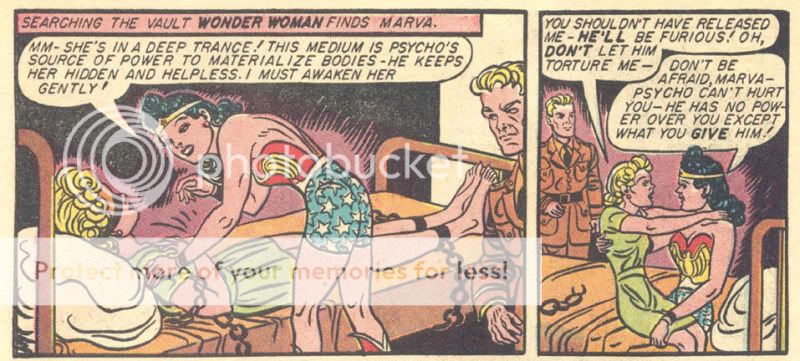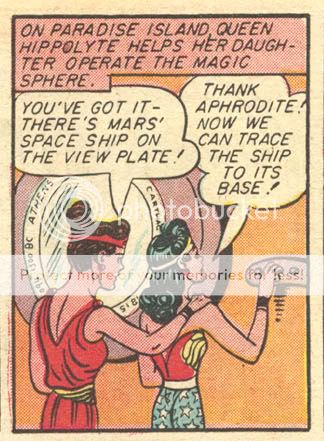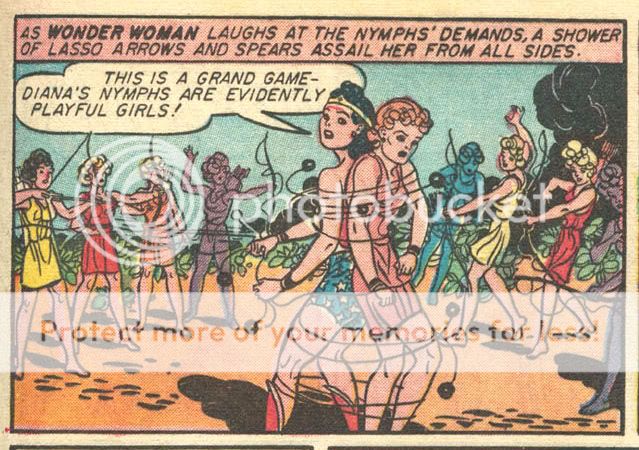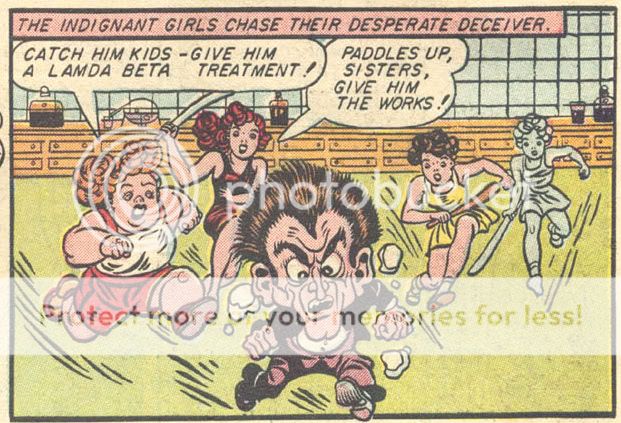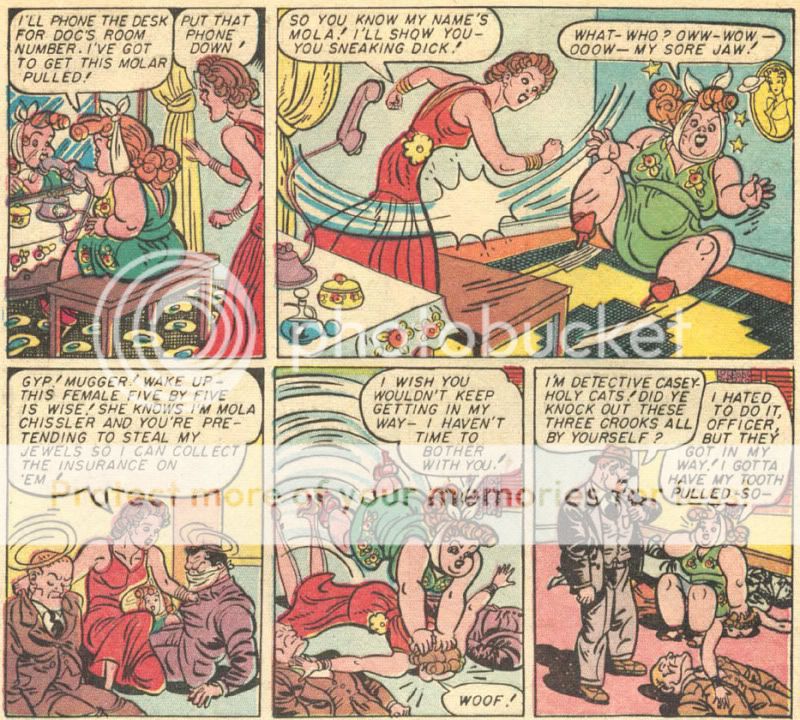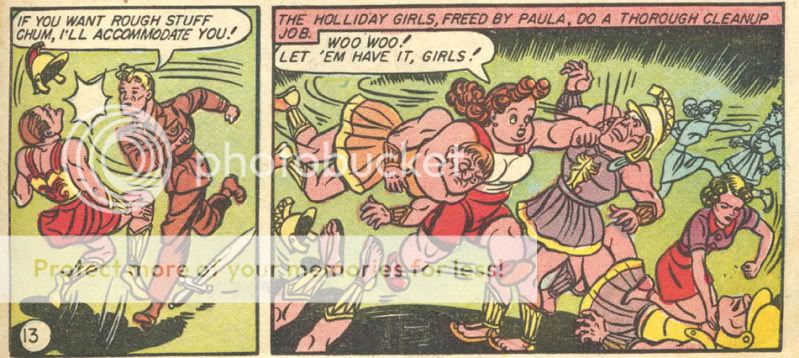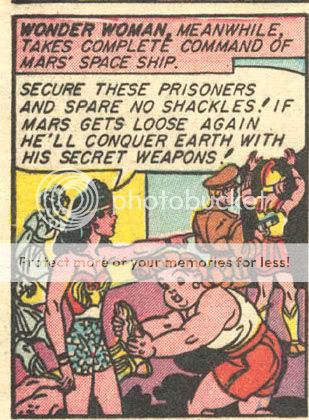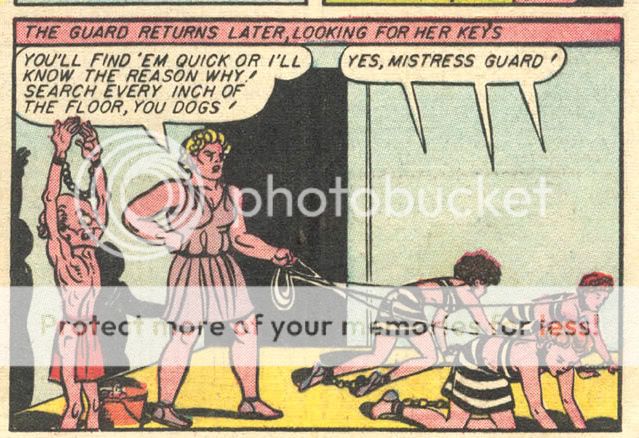Wonder Woman #9 was a high point for both Marston’s script and Peter’s art. After that, #10 is a bit of a let-down. Not that it’s bad; it’s just, comparatively (and comparatively only) kind of tame. This issue the enemy is the Saturnians who (surprise!) keep lots of slaves and fly back and forth from their planet to ours tying people up and then letting them escape and being tied up themselves and…well, you ge the idea.
Here’s the cover:
That’s a pretty great drawing. In general, Peter’s best moment in this issue involve those trippy, computer-graphics-looking pathways made out of circles. The Saturnians have decided that the best way to invade earth is to build a giant bridge out of space debris stretching all the way between the two planets. I”m pretty sure that you’d have to run into some structural problems there…but of course, I don’t wear skintight green jumpsuits either. Just goes to show whose an advanced interplanetary genius and who isn’t I guess….
You’ve got to love that in that second one they appear to be moving those space-rocks with a toy crane.
Anyway, as I said, the intricacies of the plot aren’t especially revelatory this go round. There were a bunch of moments that made me laugh, though. First is this:
That cracked me up. Diana is worried about going swimming with the Holiday girls because if she’s wearing a swimsuit, they’ll recognize her as Wonder Woman! Obviously, that’s a pretty logical concern…but that’s just why it’s funny. I mean, she’s only wearing glasses; how hard would it be to recognize her anyway?
This got me too:
His name is Mephisto Saturno. Gee, I wonder if he’s a bad guy from the planet Saturn? I guess no one will recognize him as long as he doesn’t dress in a bathing suit though.
Looking at this panel, I was reminded of Man-Thing (if you can believe that). Me and Tucker Stone have been blogging our way through the first Man-Thing essential volume. Writer Steve Gerber names his villainous evil developer F.A. Schist, which I think is both dumb and irritating. Yet, I find Mephisto Saturno charming. I was trying to figure out why that would be; why does one goofy, over-determined name make me groan, while the other makes me giggle?
I think part of it has to do with the language itself; F.A. Schist is awkward; it’s actually even difficult to pronounce. Whereas Mephisto Saturno bounces right off the tongue; it’s almost like something out of a children’s book. Come to think of it, Marston has a real affinity for nonsense language in general. Wonder Woman #9 had goofy cave man speak, and this issue has a bunch of gibberish nonsense code (in the upper right panel)
I was going to say that this is one of the few Marston ticks that I can’t really link up to any of his fetishes…but now that I think about it, I wonder. I’ve just started Les Daniels book about WW, and it talked about some of Marston’s experiments with sorority girls. Apparently, he attended a sorority ritual known as the:
“baby party”, a strange sorority ritual in which freshman initiates “were required to dress like babies.” They were also bound, blindfoded and prodded with sticks, when they resisted, wrestling ensued. Four pages of charts documented the responses of the young scholars to these activities, with Marston concluding that “the strongest and most pleasant captivation emotions were experienced during a struggle with girls who were trying to escape from their captivity.”
Who experienced those pleasant emotions again? Anyway, the point is that baby talk as a prelude to some bondage play may well have pushed some of Marston’s buttons.
Back to F.A. Schist vs. Mephisto Saturno, though. Besides the fact that the second name is more fun to say than the first, it’s also just less heavy-handed. Calling a developer a fascist is the dumbest kind of knee-jerk clichéd liberal insult. It’s bone-headed and obvious. Whereas Mephisto Saturno is just silly. Marston does have a lot of political axes to grind, and he grinds them assiduously and openly…but not oppressively. Part of it is that his ideas are nutty enough that when he lays them out there, you (or at least I) tend to laugh rather than groan. Also, I think he’s actually just more subtle than Gerber is:
Steve’s thinking how great it would be if WW stayed homed and cooked for him…but I don’t think the reader is supposed to think that’s great. In fact, later in the comic, Steve gets punished for wanting to make WW his domestic by being turned into a (sexualized) domestic himself —and significantly, he’s prattling on about food here, too:
I’m not sure the point here is exactly that Steve shouldn’t have wished servility on WW, incidentally; rather, it seems more like Marston is asying that it’s sexy to have everyone, man or woman, in a position of servility.
Along those lines, I thought this page was interesting:
Despite the claims of someas we see here, Steve doesn’t always get rescued. On the contrary, in this scene, he and WW rescue each other. It’s true that overall, WW is more likely to rescue Steve throughout the series than vice versa…but he’s hardly entirely helpless.
In fact, the more I read WW, the more the Steve-WW relationship comes across as…I don’t know if subtle is the word exactly. Vaguely viable, maybe? I was just thinking about it in relation to the Wonder Woman animated film, which also has Steve mouth obnoxious misogynist canards at points, and treats him as a somewhat equal partner in kicking ass. But the animated film is shot through with anxiety; Steve and WW have lots of dramatic tension around Steve’s issues with letting WW go into danger and his need to in general force WW to admit that men are really okay too. Whereas, in this version, when Steve talks about keeping WW out of danger, it’s more an exasperated aside than a real argument. And then there’s this:
I guess that could be seen as a misogynist diss in some sense. But it really comes across more as friendly flirtation than as an actual effort to run WW down. Especially given this:
I think he’s bragging about her there; he’s saying. The point isn’t that she did all this amazing stuff, but she’s still a silly little woman, but that despite all of this amazing stuff she did and all the danger she was in, she wasn’t perturbed…and also wasn’t unfeminine. I think that’s really the point; Marston likes femininity, so pointing out WW’s femininity can be teasingly affectionate; it’s banter, not an insult. Whereas the animated DVD was a lot less comfortable with femininity, and so many of Steve’s chauvinistic comments came across not as teasing or as friendly banter, but as anxious and mean-spirited — if I remember correctly, there’s a moment of borderline workplace harassment.
It’s also worth pointing out this sequence:
That’s from WW #2, and it’s almost an exact reversal of the scenes we just looked at; in this case, WW is teasing Steve for behaving just like a man even though he’s been captured and endangered on another planet (Mars in this case.)
All right, to finish up with the boots:
Nobody’s going to notice her running around in a gaudy swimsuit…but not wearing boots! Everybody will point and stare at her then!
_______________
I just looked ahead, and after this mild downturn, #11 features a cross-dressing hypnotist. So I’m looking forward to that.

